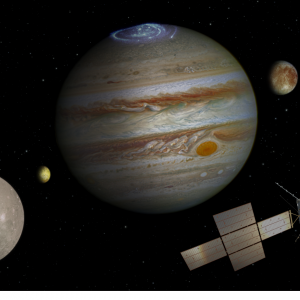Actualizado el 23/12/2025
Se inaugura el homenaje a Galileo mientras Juice se despide de EuropaEscrito por Redacción TNI el 31/01/2023 a las 23:23:471660
 As part of the final preparations a commemorative plaque was mounted on the spacecraft as a tribute to Italian astronomer Galileo Galilei who was the first to view Jupiter and its four largest moons through a telescope in January 1610. His observation that the moons changed position from night to night overturned the long-held idea that everything in the heavens revolved around Earth. The moons – Io, Europa, Ganymede and Callisto – were to become collectively known as the Galilean satellites in his honour.
The plaque, which replicates several pages of Galileo's Sidereus Nuncius where he describes his observations of the moons, was unveiled at Airbus Toulouse on 20 January. Following the event, the spacecraft will be packed for its transatlantic flight to French Guiana where it will be readied for launch on an Ariane 5 from Europe’s Spaceport.
“Unveiling the plaque is a beautiful moment in this intense chapter preparing the spacecraft for launch,” says Giuseppe Sarri, ESA’s Juice project manager. “It’s not only an opportunity to pause and reflect on the decades-long hard work that has gone into conceiving, building and testing the spacecraft, but also to celebrate the curiosity and wonder of everyone who’s ever gazed up at Jupiter in the night sky and pondered our origins – the inspiration behind this mission. Answering humankind’s big questions
Three of Jupiter’s largest moons – Europa, Ganymede and Callisto – hold vast quantities of water buried under their surfaces in volumes far greater than in Earth’s oceans. These planet-sized moons offer us tantalising hints that conditions for life could exist other than here on our pale blue dot, orbiting giant planets instead of hot stars. Jupiter and its family of large moons represent an archetype for giant gas planet systems across the Universe and as such are some of the most compelling destinations in our Solar System.
ESA and its international partners are almost ready to send Juice on its quest to explore this fascinating planet and intriguing moons. With its suite of powerful instruments, Juice will see Jupiter and its moons in a way that Galileo couldn’t even have dreamt of. The data returned by the spacecraft will serve many future generations of scientists determined to uncover the mysteries of the jovian system and its place in the evolution of our Solar System.
“With Juice's departure for the launch site fast approaching, we remember its long Earthly journey through various Airbus sites in Europe towards final integration and more than 500 Airbus employees who prepared the spacecraft for its eight-year cruise,” says Cyril Cavel, Juice Project Manager at Airbus Defence and Space. “It has been an incredible adventure, along with more than 80 companies across Europe, to bring ESA’s vision to life and ultimately study Jupiter and its icy moons in-depth.
|